May 14, 2025 | 18:46 GMT +7
May 14, 2025 | 18:46 GMT +7
Hotline: 0913.378.918
May 14, 2025 | 18:46 GMT +7
Hotline: 0913.378.918
In 2016, Mr. Dang Van Cap traveled to the Southwest region to purchase 30 Monthong durian trees for a pilot planting. This planting involved transforming mixed gardens by removing acacia trees and replacing them with economically efficient fruit trees on a 10-hectare plot in Thach Long 1 village, An Tuong Dong commune, located in Hoai An district, Binh Dinh province. Mr. Cap cultivated a total of 30 durian trees, which were placed in close proximity to 7,000 pepper poles. These plants were meticulously tended to following organic standards, ensuring that they received the proper organic care techniques.
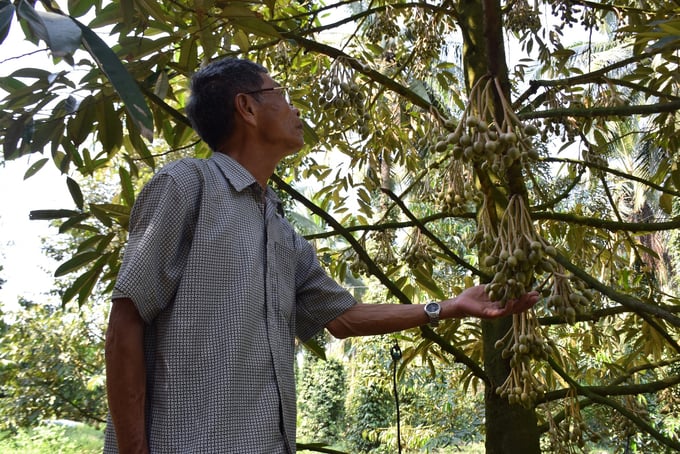
This year is the third year Mr. Dang Van Cap's durian garden has produced fruit. Photo: V.D.T.
According to Mr. Cap, for the durian crop to flourish in the unknown area of Hoai An, it requires a unique and particular care technique tailored to its needs, rather than adopting the practices of orchard owners in the Southwest.
At the age of 4, Mr. Cap started stimulating the durian plants to produce flowers and fruit. "Inducing" blossom and bear fruit is not natural and requires human involvement. After 4 years of meticulous nurturing, including the provision of fertilizer and water, Mr. Cap deliberately stopped watering the durian trees to encourage them to blossom. Subsequently, he supplied them with phosphate fertilizer and potassium to stimulate the process of blossoming.
"Before stimulating the durian trees to bloom, I had to make regular visits to the garden to discern and classify the leaves." Upon seeing the transition of the leaves from a bright green hue to a darker shade, I calculated that they were undergoing the natural process of aging. Therefore, I decided to cease the provision of water to the durian trees by refraining from watering them any more. Following a 20-day period of water deprivation, I proceeded to nourish the durian plants by using lan and potassium as fertilizers. Approximately 45 days later, the flower buds had reached a size comparable to that of crab eyes. Subsequently, I resumed the task of irrigating the trees, however with a minimal quantity of water, just enough to maintain the blooms in a state of freshness. This cautious approach was necessary to prevent an excessive amount of water from causing the flowers to detach from the trees. I applied a treatment to the trees to induce leaf shedding, and this layer of leaves serves the purpose of nourishing the flowers," Mr. Cap said.
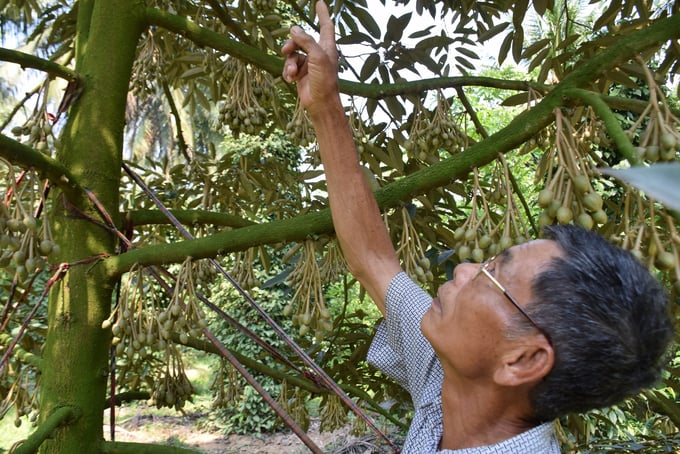
This year the weather is favorable so Mr. Dang Van Cap's durians produce a lot of flowers. Photo: V.D.T.
Following the period of tending to the flowers, the orchard owner persists in exerting significant effort throughout the phase of nurturing the fruit. When the durian flower buds reach the size of the little finger's tip, about 7 to 10 days before to blooming, it is necessary to trim them. This prevents the leaves from growing further, enabling the tree to concentrate its energy on producing fruit. At this stage, the tree need nutrients to facilitate fruit production, hence it must be sufficiently hydrated, with the water steadily rising.
As to Mr. Dang Van Cap, this year, due to favorable weather, all 30 of his durian plants had blossomed abundantly. Mr. Cap had to prune the blossoms, retaining just 5 - 7 groups of flowers and allowing 5 - 7 fruits to develop on each branch. This year marks the third consecutive year in which his durian bushes have produced fruit. Given the good weather conditions this year, Mr. Cap anticipates that each tree will produce 50 fruits, with an average weight of 3kg each fruit, resulting in a total production of 150kg per tree. Mr. Cap anticipates a yield of 4.5 tons of durian fruit this year from his 30 trees, all of which are of the same age. Mr. Cap sold his durians last year at a price of 80,000 VND per kilogram, maximizing his sales to customers in the area.
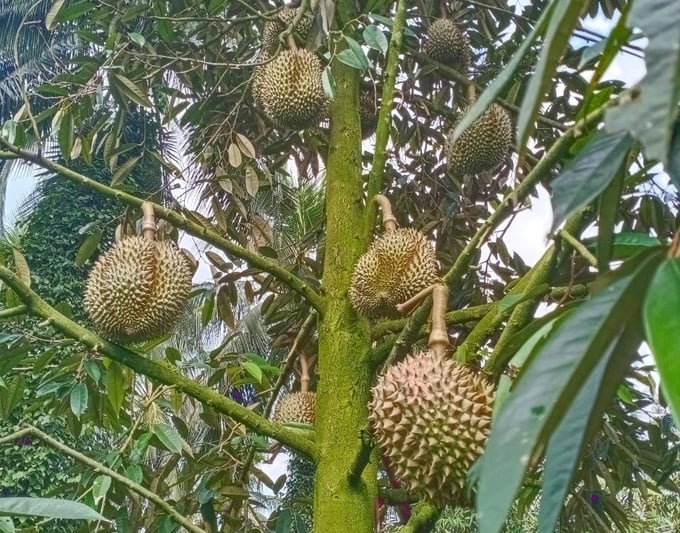
Last year, Mr. Dang Van Cap's durian garden produced very good quality fruits. Photo: V.D.T.
"Based on my calculations, having 30 durian trees this year will result in an estimated income of approximately 360 million VND. Despite having 1,000 coconut trees planted on the farm, my earnings only amount to around 150 million VND during the most profitable years. However, during years when coconut prices decline, my earnings plummet to just 100 million VND. "Mr. Cap shared that 30 durian trees generate almost triple the income of 1,000 coconut trees.
The rapid appeal of durian trees has prompted farmers in Hoai An to convert their mixed gardens by removing acacia trees from hillside terrain and replacing them with durian production.
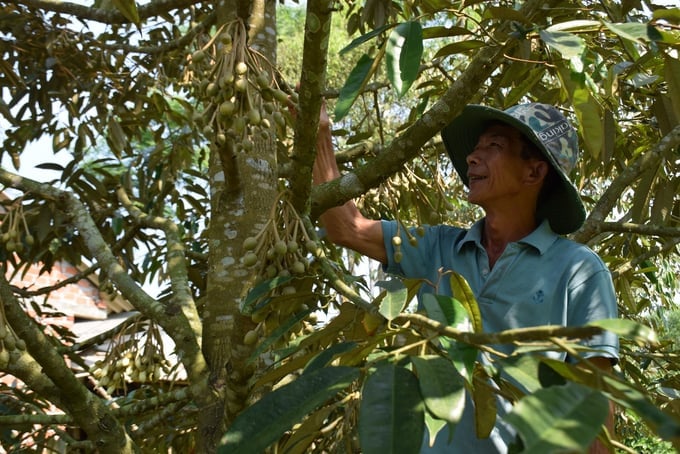
The first flowering durian trees of Mr. Vo Hoang Hien in Thach Long 2 village, An Tuong Dong commune (Hoai An district, Binh Dinh). Photo: V.D.T.
Mr. Vo Hoang Hien, aged 61, owns 10 plots of land, each measuring 500m2, in Thach Long 2 hamlet, located in An Tuong Dong commune. Originally intending to cultivate rubber plants, he quickly switched to growing durian. More than 4 years ago, Mr. Hien purchased 100 Monthong durian plants in Dong Nai province. This year marks the first flowering of his durian trees.
Mr. Hien states that the soil and environment of Hoai An are very conducive to the optimal growth of durian trees. However, as a result of his limited understanding of flower cultivation practices, the first group of blooms last year dried and dropped off. Presently, Mr. Hien is maintaining a mere 6 trees that possess the highest number of flowers. He is eliminating the blooms from the other 94 trees and commencing the prescribed procedure by the Hoai An Youth Agricultural Cooperative to effectively cultivate a second batch of flowers.
Based on the agricultural sector's monitoring and evaluation from 2016 to the present, it has been determined that durian trees, particularly the Monthong type, are suitable to the climate and soil conditions in Hoai An district. Despite the lack of proper care from farmers, durian trees thrive and exhibit robust growth, resulting in great output.

Mr. Vo Hoang Hien uses composted cow manure to fertilize durian according to the organic farming process. Photo: V.D.T.
"Due to the recent introduction of durian cultivation in Hoai An, the authorities have dispatched officials to acquire expertise in cultivation techniques from specialized units in regions with established durian farming, such as Dak Lak, in order to provide guidance to local farmers." Presently, durian cultivators in Hoai An possess expertise in methods such as water deprivation-induced blooming and bud thinning to enhance fruit development... According to Mr. Vo Duy Tin, the Head of the Department of Agriculture and Rural Development of Hoai An district, several durian orchard owners seek guidance from experienced growers in Dak Lak and Dong Nai to improve their farming practices.
Translated by Linh Linh

(VAN) Japan's efforts to lower the price of rice through the release of its stockpile may finally be making some progress, albeit at a snail's pace.

(VAN) U.S. tariffs are not only a 'shock', but also an opportunity for Vietnamese businesses to renew their mindset toward comprehensive development.

(VAN) As Bac Giang lychee enters the harvest season, Minister Do Duc Duy expects that the fruit will contribute greatly to agricultural exports due to standardized production and deep processing.

(VAN) Consumers have shown a preference for free-range eggs, but those farming systems are more vulnerable to biosecurity risks like bird flu.
/2025/05/09/5701-1-184335_301.jpg)
(VAN) Vietnam’s eel exports nearly doubled thanks to a mud-free farming model, opening up new prospects while still facing numerous barriers related to international standards.

(VAN) Minister Do Duc Duy warned that if production is not professionalized and supply chains are not transparent, the U.S. market could become a growth bottleneck.
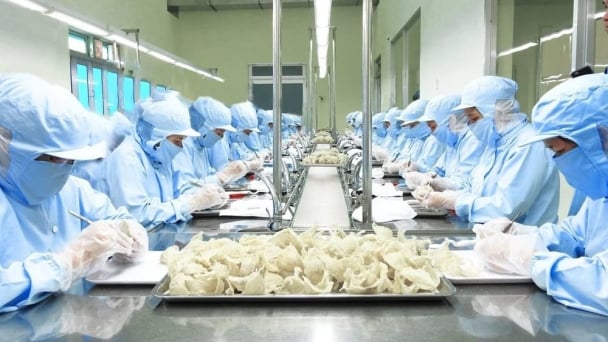
(VAN) Delegating surveillance responsibilities to local authorities is a cost-saving and efficiency-boosting measure that removes a key bottleneck for enterprises, according to Director General Duong Tat Thang.